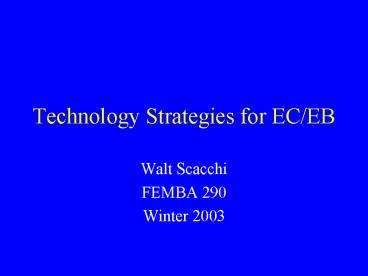Technology Strategies for ECEB - PowerPoint PPT Presentation
Title:
Technology Strategies for ECEB
Description:
Central technique embodied in each technology-based strategy ... Identify, capture and dominate a niche. ... Surround, capture, divide, 'cherry pick' ... – PowerPoint PPT presentation
Number of Views:43
Avg rating:3.0/5.0
Title: Technology Strategies for ECEB
1
Technology Strategies for EC/EB
- Walt Scacchi
- FEMBA 290
- Winter 2003
2
A sample of EC/EB technology-based strategies
- Stategic position or engagement techniques
- Central technique embodied in each
technology-based strategy - Role and implications for EC/EB technologies for
each strategy.
3
Market Exclusivity
- Identify, capture and dominate a niche.
- Technique Being first, being best, being the
only choice, being able to easily defend one's
market position. - Example Develop, acquire, or possess unique
database/repository content, or more quality
content than competitors
4
Encapsulation
- Surround, capture, divide, "cherry pick"
- Technique Erect an intermediation structure that
captures/controls access to customers and
restricts access by existing competitors, in
order to ingest or acquire them - Example Create an all-encompassing EC/EB service
5
Follow-and-Dominate
- Be "second to market", outflank first movers
- Technique let the pioneers catch the arrows,
then follow the path the pioneers have
established, but at a larger scale and scope to
discourage subsequent market entrants - Example Build a bigger DB, add more types of
data/content, provide more DB access points
6
Disintermediation or Reintermediation
- Remove or replace the legacy middle-man
- Technique Encapsulate market niche, remove/erect
(in)efficiency barriers to legacy competition - Example Provide open Web access/transactions to
EC/EB services controlled by legacy vendors
7
Aggregate Supply or Aggregate Demand
- Make a new market where one did not exist
- Technique Gather vendors products/services for
targeted customers gather potential customers
for targeted vendors - Example DB marketing using E-Catalogs or create
"magnetic" DB-centered Web sites/portals
8
Transformation
- Do legacy business processes/services in new ways
- Technique Streamline, reengineer or make
business processes Web accessible - Example Workflow automation via Web-based EC
services or EB process transaction
9
Confrontation David vs.
Goliath
- Taking on a larger established competitor
- Technique "Judo" (find your opponents
vulnerability/hinge points use their "weight" to
their disadvantage) - Example Offer DB-driven product/service
innovation for B2C
10
Integration
- Make a market niche from untapped fragments
- Technique Pull together disparate
capabilities/products into a coherent framework
that realizes economies of scale and scope - Example Create integrated views, access or
transactions to disparate EB/EC information
sources
11
Open Source
- Advocate and exploit "open source" software
development business practices to undercut
competition - Technique Establish two communities one for
commerical customers who will pay for support and
services, the other open for sharing software
source code with others - Example (1) use open source DBMS and support
environment (e.g., LAMP -- Linux, Apache, MySQL,
Perl) or (2) build commerical DBM-based
application in both "supported" (proprietary,
fee-based) and "open source" (public, no-fee or
free) versions to create new EC/EB offerings.
12
Peer-to-Peer (p2p)
- Advocate and exploit p2p technology for
local/global sharing of information resources,
contents, or workspace (e.g., a persistent or
dynamic "view" into a database) - Technique Identify information sharing DBM
applications that have a surrounding community of
users, then target each community with a p2p DBM
application service. - Example Databases for Personal Digital
Assistants (PDAs, wired/wireless Web phones),
local/global object sharing (including objects
that contain other objects), or shared workspaces
are targets of opportunity for mobile p2p EC/EB
applications.































